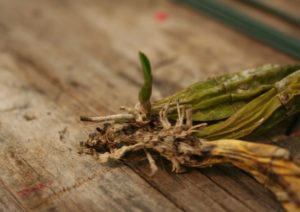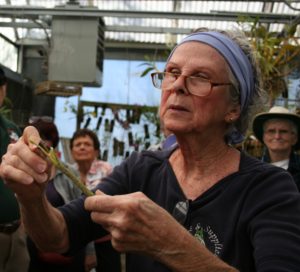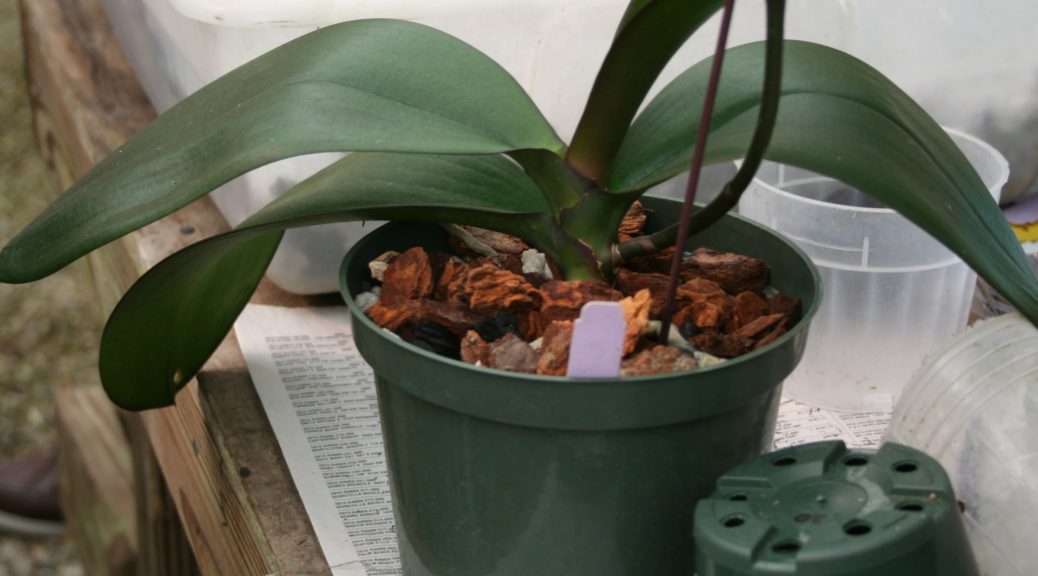by Jennifer Odom
After the confident way Suzanne Farnsworth of Sazanna’s Orchids demonstrated repotting orchids and snipping of the keikis (pronounced kay-kees) which is the Hawaiian word for child, maybe I could do it too. It didn’t seem such a scary operation.

I’ve always heard, “Just forget growing orchids, they’re too complicated and finicky. Orchids are tricky to grow, and you’ll just lose out.”
But, like with other plants, it’s less about the green thumb and more about understanding the plants. And Suzanne gave the visiting Master Gardener group plenty of tips.
For example, keep the plant out of direct sunlight, but give it nice bright light, (enough light to read by). For the phalaenopsis planted in sphaghum moss, don’t give them too much water, just 1/2 to 1/3 cup. Orchids do not like wet feet. And do not use soft water. How often? If you stick a finger in the medium and find it too dry, then water it.
It’s perfectly fine for the roots to grow out of the pot. That’s how they act. In fact, many varieties are grown on a metal hanger for support, with their roots completely exposed, just like in the jungle! They also need air movement, the more the better. It cuts down on disease. Make sure to feed them orchid food according to package directions.
Is the orchid plant loose in its planting medium?
It’s about time to repot it, which comes around about every two years. Use the proper bark medium made of sequoia, sponge rock, and charcoal.
Do not use pine or oak. Oak and pine bark are going

to rot too soon. Peat moss will retain too much moisture. Just buy the mix, which is available at Sazanna’s in Weirsdale, Florida or wherever orchids are sold.
Orchids grown on a mount such as cork, cypress boards, or redwood cedar are more natural than in pots. After all, they hang on trees in the jungle. (If you must use a pot, some of Susanna’s customers prefer clear pots for phalaenopsis orchids so they can enjoy the beauty of the roots. And too, says Susanna, the roots have a relationship with light).
Another trick Suzanne revealed is that when she must make a cut, such as separating keikis, or trimming up some roots while repotting, she uses a brand new sterile razor blade. Any tools must be cleaned so disease is kept at a minimum.
On all cuts Suzanne uses a light dusting of cinnamon powder which acts as a natural fungicide. Yes, regular old spice-cabinet cinnamon.
When dealing with young plants, an inverted u-shaped wire can be inserted into the medium to prop up bent leaves until they develop the proper memory for shape. But all orchid plants are delicate and can snap like young asparagus if handled roughly.
Because of that, when staking a flower stalk that is hanging low, you will have to do this in stages over a period of days or weeks. A quick change in direction can break them. Use a brown or green twist-tie to blend in, but do not twist. Wrap the stem smoothly and gently, remembering that the stem will grow in girth and you don’t want it to strangle.

Maybe now you’ll feel more confident too, and venture out to find an orchid or two to play with. Until you try it, you’ll never learn to understand their beautiful ways.
And stop by Sazanna’s. She’d love for you to see her beautiful greenhouse and the gorgeous varieties for sale.
Sazanna’s Orchids & Supplies

15730 S Hwy. 35
Weirsdale, Florida 32195
352-821-2147
Suzanne shows visitors that the real orchid root lies inside a surrounding spongy layer.
And God said, Let the earth bring forth grass, the herb yielding seed, and the fruit tree yielding fruit after his kind, whose see is in itself, upon the earth: and it was so. And the earth brought forth grass, and herb yielding seed after his kind, and the tree yielding fruit, whose seed was in itself, after his kind: and God saw that it was good. And the evening and the morning were the third day. KJV Gen. 1: 11-13

